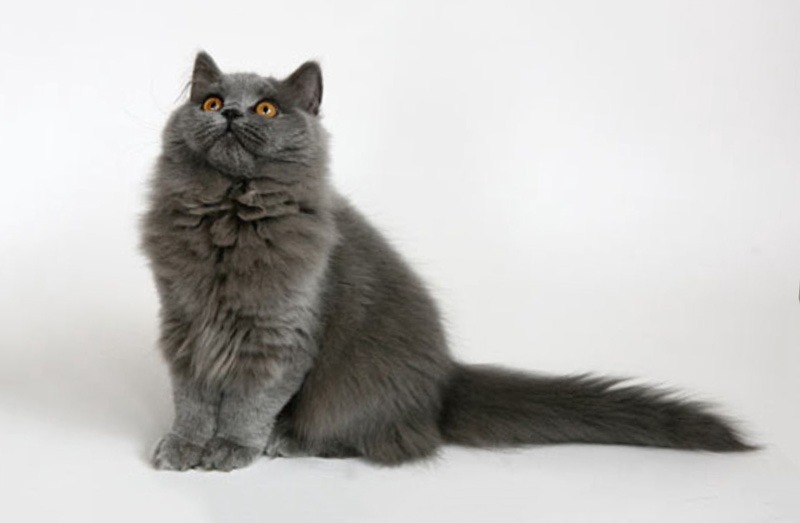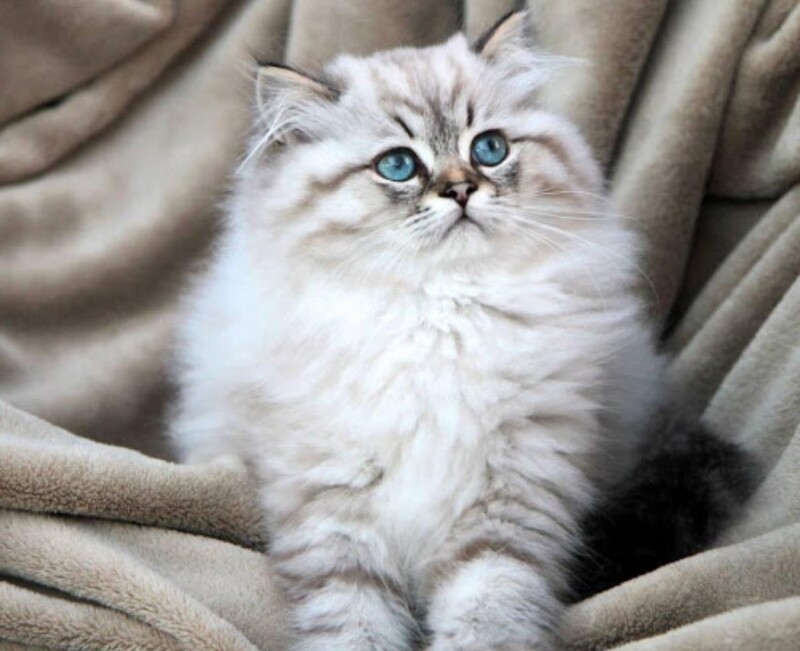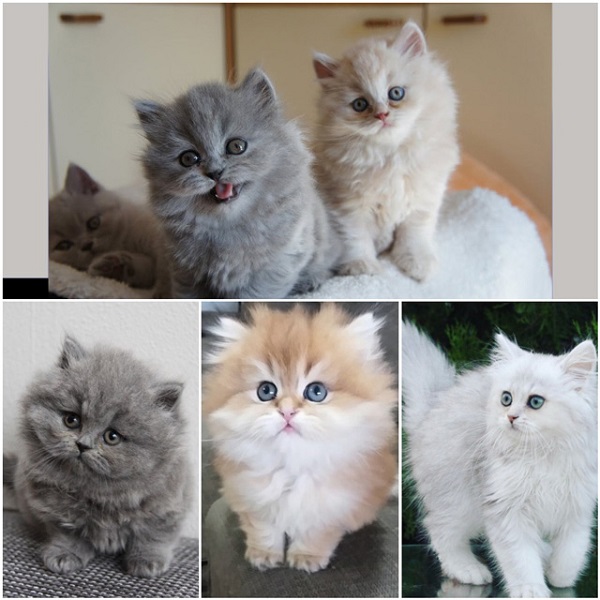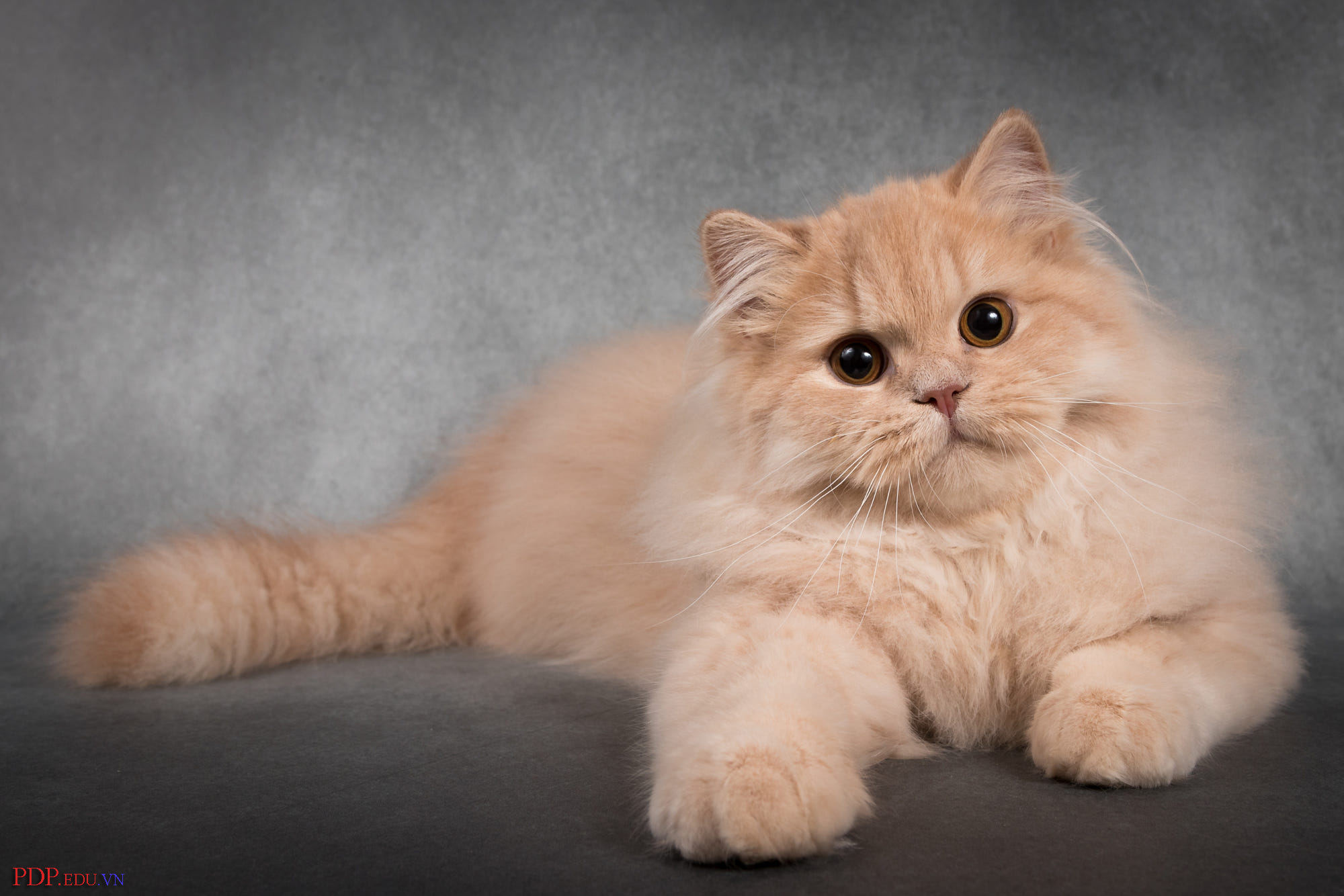Introducing the cat British Longhair and how to raise Boss

In this article, the Tinhot.asia will introduce you to the detailed characteristics of the British Longhair breed in terms of the breed's history, personality, basic care instructions, and most importantly, the British cat's price. long hair before choosing this cat as your pet, let's start learning now.
Overview of the British Longhair cat breed

– Weight: 3.5kg – 7.3kg; male cats tend to be larger than female cats
– Body length: 55cm ~ 63cm
– Coat: Short and dense
– Color: bluish gray (most common), white, black, red, cream, tricolor, bicolor, tabby, smoke..
– Eye color: bronze, green, yellow, blue
– Breed life: 12 – 16 years (maybe more depending on diet and exercise)
Origin of British longhair cat
Hearing the name of this cat breed, people will probably think of the British Shorthair breed. This is completely understandable because this can be considered a hybrid of a British short-haired cat and a three-year-old cat. private. Initially, this crossbreeding happened to increase the gene pool for short-haired cats to find superior traits. These longhair genes are considered recessive and will appear in a few individuals when the mother or father crosses the Persian with several litters.
Thanks to the breed's rather beautiful appearance, in 1914 and 1918 breeders worked hard to find and breed the British Longhair. Not long after that, the breed became extremely popular without its predecessor
Later, the British Longhair breed began to be recognized as an independent breed by pet associations around the world (in 2009, British Longhair was recognized by the international cat association TICA). The most characteristic difference between British Longhair and British Shorthair is only in coat length, which also makes them appear larger than British Shorthair due to the length of the coat.
Characteristics of the British Longhair cat
Personality of British Longhair
The British Longhair is full of mixed personalities between the ALN and Persian cat breeds, these cats have a rather calm personality, sometimes a bit short-tempered. Similar to most other cats, they love attention and contact with their owners, especially being petted or played regularly.
Emotionally, the British Longhair is a loving and friendly cat and will also show a lot of tolerance. They get along well with people when around, but this breed is also happy to enjoy their own time, which makes them a smart choice for people who may be away from home for long hours due to busy schedules. with work.
Despite the laid-back British Shorthair, it is important to encourage the breed to be active and engage in exercise. Consider the British Longhair as a breed of cat where you need to invest time and effort when around them to get the most out of them.
Also note that the British Longhair is an affectionate cat, but they usually don't like to be held or carried around. They are a breed that can be more suited to an adult lifestyle than a dog that is always noisy with children.
One thing that most people think is unlikely is training cats to be obedient in the same way as dogs. However, the British Shorthair cat is a fairly intelligent cat breed, the ability to learn very quickly, you can train it with some basic exercises so that the cat can be more active. One of the basic exercises that you can practice is not to let the cat beg at the table. It seems that it is very simple with this intelligent cat to build a good character for them.
The appearance of the British long-haired cat
Like its short-haired brother, the British long-haired cat gives me a fat and chubby appearance (of course you also like a fat cat right :D) The most ideal breed conditions for British Longhair are: muscular but not fat.
The legs are relatively short compared to other cats with thick fur that makes you feel like they are much fatter than short-haired cats, the chest is wide and strong for a softer gait.
The head of this cat breed is quite round and large, making it feel good to rub the head, the small ears and big, dark eyes come with long, fluffy fur that makes you feel exactly like a stuffed animal (ready to be). break your heart anytime)
The hair is the most prominent feature of the British Longhair breed, which is inherited from the Persian cat breed, but the length seems to be incomparable, so it is often classified as "semi-long". The special thing being said here is that about the thickness of the coat inherited from the British Shorthair the coat seems to be more ruffled and looks more luxurious. British Longhair's coat has many different colors, let's find out the details below
In terms of size and weight, this is a medium-sized cat, females weigh from 4 to 6 kg, males are usually larger and sometimes up to 8 kg. Compared to larger-bodied cats like the Maine Coon, the longhair doesn't seem to be outdone due to the thickness of its coat.
Learn about the coat color of your long-haired cat

Colourpoint British Longhair Cat : Monochromatic color group, British Longhair cats in this group only have a single coat color covering all parts of the body
Chinchilla British Longhair Cat : This is a rather special version of the British Longhair, they have black paw pads and a beautiful silver-white coat. Chinchilla cats are often very expensive because of their beauty
British Longhair Tabby Cat : A rather distinctive color inherited from the British Shorthair cat, which can be described as having a dominant color and streaks of other colors intermingled and evident in the coat. However, due to the long coat of this breed, it is difficult to see the color streaks clearly
British Longhair Cat Tortie : Also a color combination between two colors that blend together on the coat. But Tortie differs from Tabby in that these two color spaces do not have a clear boundary, but blend together (also known as tortoiseshell color ) common in female British Longhair cats.
Torbie British Longhair Cat : A mix between Tortie and Tabby in terms of color
Bicolor British Longhair Cat : Describes British Longhair cats with a white color and an accompanying color. Normally, bicolor color will have two main colors: white - gray (lilac) or white - orange
Basic long-haired cat care instructions
British Longhair cats need a bit of coaxing to ensure they stay active and get enough exercise. Otherwise, feline obesity and other related health problems can result.
A smart way to encourage this breed to exercise is to use games and cure-based play sessions. Also, consider interactive feeding devices if it looks like your British Longhair is becoming too much of a lying cat.
Along with scheduling an annual vet visit, your Queen of England will need regular checkups and manicures. If you are new to cat maintenance, your veterinarian can show you the safest way to do this. Adding a scratching post to your habitat can also help promote healthy scratching and keep your cat's nails in good condition.
In addition to nail care, check your British Longhair's ears for signs of dirt accumulation or possible infection every few weeks. Also talk to your vet about starting a regular brushing regimen that's right for your British Longhair.
Care regimen for British long-haired cats

Because the coat of this cat breed is too long and dense, it requires you to take care of them more than the British Shorthair cat. However, there is no need to take care of every glass. Brush your longhaired cat about once a week so not too much can cause their hair to fall out. However, during the shedding season of British Longhair cats you can brush them more than about 2 or 3 times a week.
British Longhair cats should be introduced to brushes and combs from an early age to develop a good habit and they will not cause discomfort when combing later. Choose a brush that is suitable for kittens for example a soft bristle brush (it can make brushing longer because it does not pull the hair well but does not affect the cat's skin) can change the brush Fishing harder when the cat is an adult
Cats are generally clean animals, they can take care of their own coat with a tongue covered with many small teeth like a comb, which is definitely the most effective hair care tool. However, this results in them swallowing a significant amount of hair after each self-cleaning process. To help remove this hair from the body, you can use a common food called "cat grass" or other common special foods.
Make sure your longhair cat's diet is full of nutrients with quality ingredients, it's best to feed them as little sugary foods as possible.
Common diseases in British long-haired cats
Despite having quite strong resistance, they are often less susceptible to infectious diseases. However, British Longhair often suffers from a common disease that Shorthair's predecessor also suffers, which is "obesity". Obesity in cats can make you look very cute, but always has the potential to lead to other blood and respiratory diseases. The best solution in this case is to regularly let the cat be active simply by playing with them
A rare condition in British Longhair that occurs due to genetics is kidney disease. This genetic disease is common in British Shorthair and Persian cats, so the hybrid of these two breeds is no exception. Renal cysts develop very early in the childhood British Longhair years and are easily detected by ultrasound
The other type of disease seen in this breed is a heart disease (hypertrophic cardiomyophthy - HCM) that occurs more often. Regular echocardiography is the best way to detect this disease in its early incubation period. This disease often has no treatment and should be excluded from the breeding of cats carrying this disease, but if detected early and appropriate treatment measures are taken, infected cats can still live. quite a while
Diet for long-haired cats
In terms of nutritional requirements, British Longhair cats are not too different from other cat breeds. The best foods for British Longhair are wet or dry foods with nutrient and protein content. Plant-based foods are not recommended and should only be included in the supplement list, not the main meal.
In addition to the main foods, complementary foods such as dry food to help support hair loss, foods to help avoid hairballs or cat grass can be used every few months to help cats stay healthy.
In addition, if your British Longhaircat has symptoms of HCM or kidney cysts, you can take it to your veterinarian for advice on other suitable nutrition regimens.